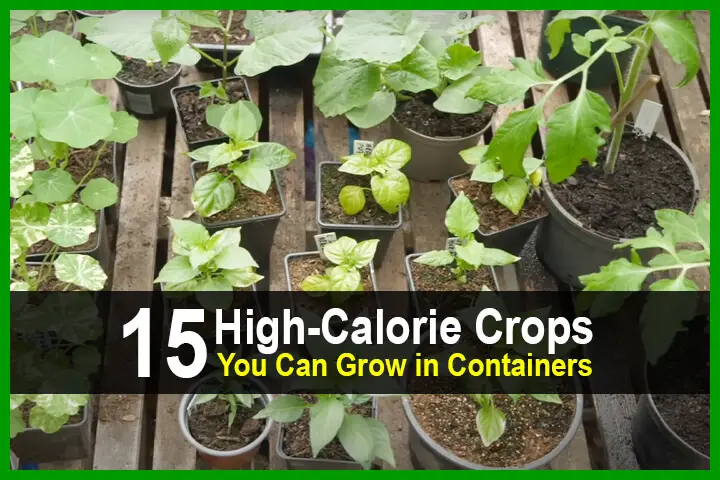Estimated reading time: 9 minutes

Container gardening may not seem like the ultimate in survival gardening; but for some preppers, it’s the only way to go.
Preppers who live in apartments can either choose container gardening or give up on gardening altogether. Considering that they typically don’t have enough storage space for a good stockpile, choosing not to container garden just shortens the time till they run out of food.
But is container gardening even a viable alternative? Can you grow enough calories to keep you going? With salads and veggies basically being “diet food”, it might not seem like it’s possible to do much with a container garden.
But that’s far from the truth. While leafy vegetables are low in calories, root vegetables are some of the highest-calorie foods we eat. It’s all about making the right choices.
That includes making the right choices in which containers you use. Don’t forget, container gardening can refer to any size containers, even big ones.
While it may not seem practical to grow larger plants in containers, people actually do so all the time. They even grow trees in containers, although about the only trees that most of us could grow indoors would have to be dwarf fruit trees.
The biggest challenge in growing any plant indoors is them getting enough light. Your home only has so many windows, and you’ll probably end up having plants in front of each of them.
Another option you might want to consider is using LED grow lights. These are energy-efficient enough that you can power them off of solar panels when the power is out. You’ll want those solar panels to be charging a battery, so that you’ll have power for your grow lights when the sun is down or on days with a lot of cloud cover.
For watering purposes, you want to make sure that all your grow containers have drain holes in the bottom to eliminate the risk of overwatering. Put some sort of catch tray there, so that any water coming out of the bottom of your plant pots doesn’t end up destroying your flooring.
With all that in mind, let’s take a look at some high-calorie crops that grow well in containers.
Avocado
Avocado trees offer a substantial amount of calories thanks to the high fat content of the fruit. Dwarf varieties of avocado trees are best. They need deep pots to accommodate their root systems along with plenty of sunlight and regular, deep water.
You’ll need to be patient as production might take a few years, but the nutritional benefits are worth it.
Beans of all Sorts
Beans are a classic survival food, being high in both protein and calories. Actually, they’re even higher in calories than potatoes. However, you don’t get as much volume of edible vegetable from a bean stalk as you do from a potato plant. So, there’s a tradeoff there to consider.
Beans can be planted fairly close together, with individual plants being 2 to 4 inches apart. However, they usually say to plant them in rows that are 30 to 36 inches apart, to provide room for the leafy part of the plant.
Looking at that another way, some say to plant 4 to 6 plants per “hill.” We can equate that hill to a planting pot, putting several plants together in one pot.
Beets
Beets are high in sugar, adding to their calorie count. You can even up the calorie count more by pickling them. Typically, cooked beets have 75 calories to the cup, but pickled ones have more than 100. Beets are also a good vegetable to grow because the greens can be eaten. While those greens are not high in calories, they are high in nutrition.
Beets can be planted close together, keeping in mind that they are more spherical than carrots. I used to intersperse rows of beets in with my carrots, planting five rows of carrots, then one of beets. I planted them 2” apart, although they can be planted as close as 1.5” apart.
Bell Peppers
There’s a lot in common between growing bell peppers and growing tomatoes. Both take up about the same amount of room; both grow to be large garden plants; and both keep giving you fruit until the fruit freezes.
As far as overall amount of food that you can get per plant, bell peppers and tomatoes are a couple of the best choices you can make.
Carrots
While nowhere near as energy dense as potatoes, carrots have one major advantage for container gardening over other vegetables. That is, they don’t need a lot of horizontal space. You can plant individual seeds one inch apart and still grow healthy carrots.
The trick here is that the soil needs to be 12 to 16 inches deep. That can be problematic for most containers, but you can plant them in five-gallon buckets or make a container by cutting the top off a five-gallon water jug. Carrots also grow fairly quickly, coming to maturity in 60 to 80 days.
Corn
Believe it or not, corn can be grown in containers, although it requires a bit more space and care than some other crops. The great thing about corn is that it’s high in calories, useful in any number of dishes, and can easily be dried and stored for later use.
For successful growth, choose a large, deep pot for each corn stock so there’s plenty of space for the roots. Corn is a heavy feeder and requires regular watering and fertilization. You’ll also want to grow several plants close together for proper pollination, which is vital for developing the ears.
Fruit Trees
I mentioned fruit trees in the introduction to this article. Dwarf fruit trees make excellent house plants. While their root system needs a good-sized pot, that really isn’t a problem.
Place that pot at the end of the sofa, and build a lid for it, with a hole in the center. That way, it can serve as an end table, as well as a place for your dwarf fruit tree to grow.
Melons
Some types of melons, such as cantaloupe and watermelon, can be planted in containers. These melons grow on creeping vines, so they can be planted in a good-sized pot and you can train the vine to grow behind the furniture, around the perimeter of the room, where it will be out of the way.
Just make sure you keep track of where the melons are growing, so that you can keep them from getting trapped underneath the furniture, where they will become deformed.
Olives
Olives are especially good for gardeners in warmer climates or the ability to provide plenty of sunlight even indoors. Olive trees are known for hardiness and ability to adapt to a variety of conditions, but they do best in deep containers with well-draining soil and full-sun exposure.
While olive trees take several years to produce fruit, the caloric value of olives—especially when pressed into olive oil—makes it worth the wait.
Parsnips
These vegetables are a close relative of the carrot, although one which packs more calorie density into the root. They can be used as a potato substitute or cut up and put into soup. If you’re growing them outdoors on the patio, they don’t die when the first frost comes along. In fact, many people say that they need that first winter frost to taste sweeter.
The root part of parsnips needs about the same amount of space that carrots do, but the leafy part of the plant needs much more. So, you’d probably be best off planting them along with other vegetables, even carrots, to maximize your planting space.
Potatoes
Of all the things you can grow, potatoes provide the most calories, contributing largely to the obesity problem here in the United States, thanks to the fast-food industry. But you’d be surprised how little space you need to actually grow potatoes.
Typically, the rows are spaced 24 to 36 inches apart, with only 15-25 inches between individual plants. The starters only need to be 6 to 8 inches deep, so if you can find a wide, shallow pot, you can grow them in a container.
One thing to consider here is building your own container, much like a raised bed, with a bottom. Give yourself 12 inches of soil depth, so that there’s plenty of room for the potatoes to grow.
Squash
Squash, including varieties such as acorn and butternut, is great for container gardening. They’ll need large containers for their sprawling vines, and they prefer well-drained soil and plenty of sunlight. Be sure to use a trellis and train the vines to grow up it. This will save space and stop the fruits from resting on the soil where they can rot.
Growing Squash in Containers & Pots
Strawberries
Growing strawberries in hanging pots has almost become a cliché, it has become so popular. Not only that, but you can grow the plants upside-down out of the drain hole in the bottom of the pot, making it possible to get twice the number of strawberries per pot.
As with the tomatoes and bell peppers, once strawberries start giving fruit, they will continue doing so. They’ll continue growing for three years, but after that, the plants need to be replaced.
Sweet Potatoes
While not quite as high in calories as white potatoes, sweet potatoes are still packed full of calories, while tending to be more nutritious. They need roughly the same amount of room as white potatoes do, so if you can find space for one, you can find space for the other.
Both white and sweet potatoes are a great choice to put down on the bottom if you’re going to be doing any container gardening. The leaves will grow up and around the other plants to get the sunlight they need, while the weight of the dirt forms a solid foundation for whatever sort of container holder you build.
Tomatoes
People have grown tomatoes indoors for years, with many people in colder climates starting their tomatoes indoors every year, before moving them outdoors to plant. But they can be kept indoors, in their containers as well. They need a lot of light, so you’ll want to place them in a window.
One nice thing about growing tomatoes is that once they start to bear fruit, they’ll continue bearing fruit until the first freeze. Of course, if you’ve got them indoors, they won’t feel that freeze, so they’ll continue bearing fruit. You can get a lot of tomatoes off of a plant or two, but the plants take up a fair amount of space.
You May Also Like:
Read the full article here




